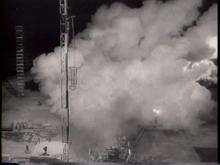Vanguard TV3BU

Newsreel of Vanguard TV3 Backup launch

Vanguard 1 type satellite electronics card

Vanguard rocket cutaway view
Vanguard TV3BU, also called Vanguard Test Vehicle Three Backup, was the second flight of the American Vanguard rocket. An unsuccessful attempt to place an unnamed satellite, Vanguard 1B, into orbit, the rocket was launched on February 5, 1958. It was launched from Launch Complex 18A at the Cape Canaveral Air Force Station. Fifty seven seconds after launch, control of the vehicle was lost and it failed to achieve orbit. At 57 seconds the booster suddenly pitched down. The skinny second stage broke in half from aerodynamic stress, causing the Vanguard to tumble end-over-end before Range Safety sent the destruct command. Cause of the failure was attributed to a spurious guidance signal that caused the first stage to perform unintended pitch maneuvers. Vanguard TV3BU only reached an altitude of 6 km (3.7 mi), the goal was 3,840 km (2,390 mi). Solar cells on Vanguard 1B satellite were manufactured by Bell Laboratories.[1][2][3][4]
The failure was a set back in the space race, which let the Soviet Union gain. Thus Vanguard was not the first rocket to orbit an unmanned satellite. The first small-lift launch vehicle was the Sputnik rocket, which put into orbit an unmanned orbital carrier rocket designed by Sergey Korolyov in the Soviet Union, derived from the R-7 Semyorka ICBM. On 4 October 1957, the Sputnik rocket was used to perform the world's first satellite launch, placing Sputnik 1 satellite into a low Earth orbit.[5][6][7][8][9]
Early Vanguard project tests has no failures. Vanguard TV0, Vanguard Test Vehicle zero was a successful one stage test done on December 8, 1956. Vanguard TV1 was a successful one stage test done on on May 1, 1957. Vanguard TV2 was a successful stage one test on October 23, 1957. Vanguard TV3BU failure followed Vanguard TV3 failure, putting the project in chaos. But the next launch, Vanguard 1 on Vanguard TV4 was successful and put into orbit the fourth artificial Earth orbital satellite and the first satellite to be solar powered.[10]
See also
Further reading
- Mallove, Eugene F. and Matloff, Gregory L. The Starflight Handbook: A Pioneer's Guide to Interstellar Travel, Wiley. ISBN 0-471-61912-4.
References
- ↑ Gunter's Space Page., Vanguard
- ↑ youtube.com, Vanguard Rocket Second Launch Attempt - 1958 US Navy Satellite Launch Failure - WDTVLIVE42, news reel footage
- ↑ NASA, Vanguard TV3BU
- ↑ NASA, NASA History Chapter 11
- ↑ NASA, Sputnik 1
- ↑ russianspaceweb.com Sputnik
- ↑ (Russian) Sputnik Rocket
- ↑ archives.gov, Report on Vanguard
- ↑ NASA, Vanguard Tech Notes
- ↑ Vanguard I the World's Oldest Satellite Still in Orbit, accessed September 24, 2007
|
|---|
| | | Payloads are separated by bullets ( · ), launches by pipes ( | ). Manned flights are indicated in bold text. Uncatalogued launch failures are listed in italics. Payloads deployed from other spacecraft are denoted in brackets. |
|


